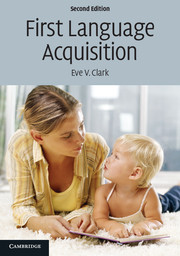Book contents
- Frontmatter
- Contents
- List of tables, boxes, and figures
- Acknowledgements
- 1 Acquiring language: Issues and questions
- Part I Getting started
- Part II Constructions and meanings
- 7 First combinations, first constructions
- 8 Modulating word meanings
- 9 Adding complexity within clauses
- 10 Combining clauses: More complex constructions
- 11 Constructing words
- Part III Using language
- Part IV Process in acquisition
- Glossary
- References
- Name index
- Subject index
10 - Combining clauses: More complex constructions
from Part II - Constructions and meanings
- Frontmatter
- Contents
- List of tables, boxes, and figures
- Acknowledgements
- 1 Acquiring language: Issues and questions
- Part I Getting started
- Part II Constructions and meanings
- 7 First combinations, first constructions
- 8 Modulating word meanings
- 9 Adding complexity within clauses
- 10 Combining clauses: More complex constructions
- 11 Constructing words
- Part III Using language
- Part IV Process in acquisition
- Glossary
- References
- Name index
- Subject index
Summary
Speakers can add complexity in another way, by combining two or more clauses into a single utterance. This allows for linking clauses through coordination (where neither clause is syntactically dependent on the other) or through subordination. In subordinate constructions, one clause (the subordinate clause) is embedded in the matrix or main clause. This embedding can take one of two main forms. In the first, the embedded clause fills one of the grammatical roles in the matrix clause and acts as the subject or object, for instance, of the matrix verb (e.g., That Tim arrived early shocked them, Nan invited them to go skiing, Bill thought that they had already eaten). This is a type of complementation. In the second, the embedded clause modifies one of the constituents of the matrix clause. It can modify a noun phrase, for instance with a relative clause (e.g., The house that was covered with ivy stood back from the street), or modify a verb phrase with a temporal clause (e.g., Kate opened the door when she heard the cat outside). These modifications typically allow for more elaborate identifications of referents in conversation and for identifications of events as related in time (sequential or simultaneous, for instance), as related by cause and effect, or as related through contingency.
All these devices allow speakers to convey more complex information in a single utterance and to produce coherent sequences of utterances when, for instance, recounting an adventure, telling a joke, or explaining how a toy came to be broken.
- Type
- Chapter
- Information
- First Language Acquisition , pp. 229 - 253Publisher: Cambridge University PressPrint publication year: 2009



